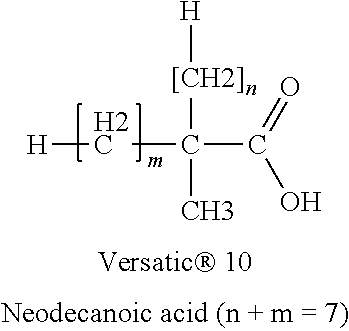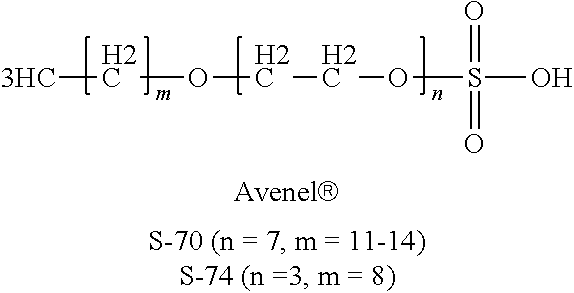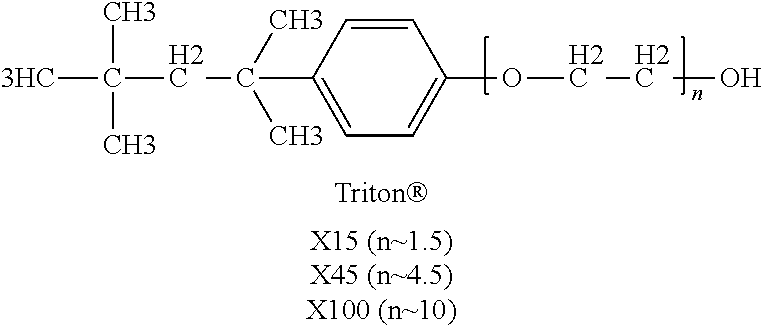Fluoropolymer Dispersion Treatment Employing High pH and Oxygen Source to Reduce Fluoropolymer Resin Discoloration
a technology of fluoropolymer resin and dispersion treatment, which is applied in the field of thermally induced discoloration reduction of fluoropolymer resin, can solve the problems of fluoropolymer resin thermally induced discoloration, undesirable color formation or increase, and undesirable gray or brown color. , to achieve the effect of reducing thermally induced discoloration
- Summary
- Abstract
- Description
- Claims
- Application Information
AI Technical Summary
Benefits of technology
Problems solved by technology
Method used
Image
Examples
example 1
PTFE, NaOH pH=10, Ozone, 2.17 Hour @75° C.
[0089]To a 2000 ml jacketed resin kettle is added 483.6 gm of PTFE Dispersion as described above having a solids content of 18.6 wt %. Net weight is raised to 1800 gm with deionized water. While agitating at 300 rpm, the dispersion is heated to 75° C. by setting the appropriate temperature on the jacket circulating bath. Once at temperature, pH of the dispersion is adjusted to 10 by adding approximately 8 drops of 50 wt % sodium hydroxide solution to the resin kettle. The dispersion is injected with ozone enriched air through a 25 mm diameter sintered glass, fine bubble, injection tube. Ozone thus injected is provided by a Clearwater Technologies, Inc. Model CD-10 ozone generator which is operated at maximum power with an air feed rate of 100 cc / min. Dispersion temperature is held constant and agitation is continued for 2.17 hours. The resulting, treated dispersion is coagulated and isolated as described above, dried in the apparatus for dry...
example 2
PTFE, NaOH pH=10, Ozone, 3.0 Hours @50° C.
[0090]The procedure of Example 1 was repeated except the dispersion is heated to 50° C. rather than 75° C. and the treatment is conducted for 3 hours rather than 2.17 hours. L* obtained for this polymer is 59.3 with a % change in L* of 35.5% indicating a much improved color after treatment. The measured color is shown in Table 1.
example 3
PTFE, NaOH pH=10, Oxygen, 3.0 Hours @50° C.
[0091]To a 2000 ml jacketed resin kettle is added 465 gm of PTFE Dispersion as described above having a solids content of 19.4 wt %. Net weight is raised to 1800 gm with deionized water. While agitating at 300 rpm, the dispersion is heated to 50° C. by setting the appropriate temperature on the jacket circulating bath. Once at temperature, pH of the dispersion is adjusted to 9.9 by adding approximately 8 drops of 50 wt % sodium hydroxide solution to the resin kettle. The dispersion is injected with oxygen through a 25 mm diameter sintered glass, fine bubble, injection tube. Dispersion temperature is held constant and agitation is continued for 3.0 hours. The resulting, treated dispersion is coagulated and isolated as described above, dried in the apparatus for drying of PTFE polymers and finally evaluated for discoloration. L* obtained for this polymer is 54.2 with a % change in L* of 23.7% indicating a much improved color after treatment. ...
PUM
| Property | Measurement | Unit |
|---|---|---|
| Temperature | aaaaa | aaaaa |
| Temperature | aaaaa | aaaaa |
| Fraction | aaaaa | aaaaa |
Abstract
Description
Claims
Application Information
 Login to View More
Login to View More - R&D
- Intellectual Property
- Life Sciences
- Materials
- Tech Scout
- Unparalleled Data Quality
- Higher Quality Content
- 60% Fewer Hallucinations
Browse by: Latest US Patents, China's latest patents, Technical Efficacy Thesaurus, Application Domain, Technology Topic, Popular Technical Reports.
© 2025 PatSnap. All rights reserved.Legal|Privacy policy|Modern Slavery Act Transparency Statement|Sitemap|About US| Contact US: help@patsnap.com



